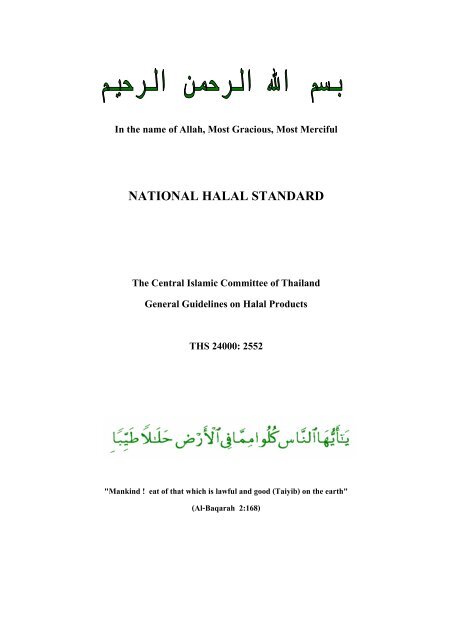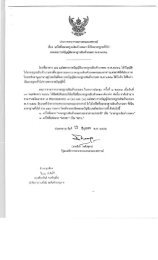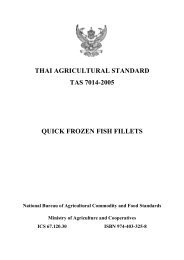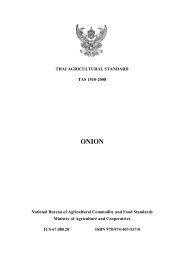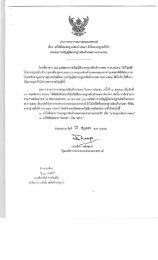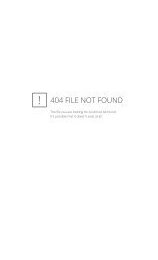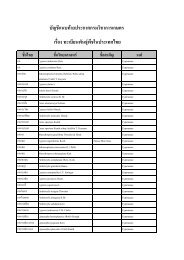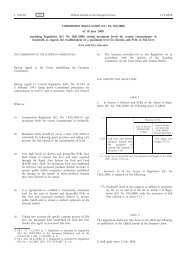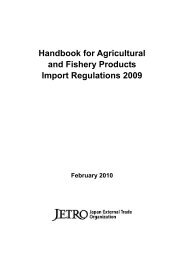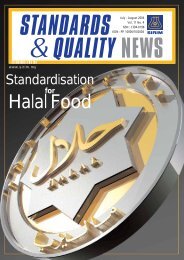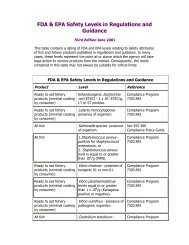NATIONAL HALAL STANDARD
NATIONAL HALAL STANDARD
NATIONAL HALAL STANDARD
Create successful ePaper yourself
Turn your PDF publications into a flip-book with our unique Google optimized e-Paper software.
In the name of Allah, Most Gracious, Most Merciful<br />
<strong>NATIONAL</strong> <strong>HALAL</strong> <strong>STANDARD</strong><br />
The Central Islamic Committee of Thailand<br />
General Guidelines on Halal Products<br />
THS 24000: 2552<br />
"Mankind ! eat of that which is lawful and good (Taiyib) on the earth"<br />
(Al-Baqarah 2:168)
CONTENT<br />
1. Scope 4<br />
2. Criterion Reference 4<br />
3. Terms and Definitions 5<br />
3.1 Halal Food<br />
3.2 Prerequisite Programs<br />
3.3 Food Additives<br />
3.4 Food Chain<br />
3.5 Cold Chain<br />
3.6 Genetically Modified Food<br />
3.7 Aquatic Animals<br />
3.8 Amphibious Animals<br />
4. Food Group Classifications 11<br />
5. Requirements 12<br />
5.1 Sources of Food<br />
5.2 Rules of Slaughtering<br />
5.3 Meat and Meat Products<br />
5.4 Milk and Dairy Products<br />
5.5 Egg and Egg Products<br />
5.6 Cereal and Cereal Products, Vegetable and Animal Oils and Fats,<br />
Sugar and Confectionery Products<br />
5.7 Beverages<br />
5.8 Genetically Modified Food<br />
5.9 Food Additives<br />
5.10 Packaging Materials<br />
5.11 Other Products<br />
5.12 Food Service and Premise<br />
6. Food Manufacturing Process 21<br />
7. Machines, Utensils, Tools and Processing Aids 22<br />
8. Storage, Display, Service and Transportation 22<br />
9. Hygiene and Sanitation 22
10. Food Safety 23<br />
11. Verification Methods 23<br />
12. Identification and Traceability 23<br />
13. Presentation to the Market 23<br />
13.1 Packaging and Labeling<br />
13.2 Service and Selling Premise<br />
14. Cooperate Social Responsibilities 25<br />
15. Consumer Protection 25<br />
16. Legal Requirements 25<br />
Bibliography 26
FOREWORD<br />
Islam is religion to be inconsistent with reason and integrate with original human nature. Its<br />
teaching originates from outstanding and unique revelation (Wahi) given by the God so it is able to fulfill<br />
the needs of mankind such as cultural, social, economical, ethical and believe. Islam comprises rules,<br />
regulations, methods and systems for existence in both the material world and the hereafter.<br />
A main factor of human existence is food and everybody cannot survive if malnutrition. Islam<br />
clearly prescribes rules of consumption as follows : Muslims shall have foods which are lawful according<br />
to Islamic law with good for health. Phrase "Foods which are lawful according to Islamic law or halal<br />
food" has widely meaning, firstly sources of food are lawfully acquirement , free from thievishness or<br />
corruption, those are ethical halal. Secondarily halal in terms of types or categories of things namely it is<br />
consideration of things to be consumed such as animals or ingredients that are contained in any food are<br />
approved by Islam or not, those are physical consideration that are they permitted ? In addition to the both<br />
conditions above, It also focus on "Processing" or stages of manufacturing commencing from slaughter,<br />
washing and cleansing, packaging, storage, transportation, selling etc. Regarding Procedural Halal<br />
focusing is also important in terms of halal consideration of things to be consume.<br />
Generally Islam is a duty of Muslims and they must implement Islamic law in determining things<br />
to be consumed as well as responsibilities of each Muslim based on attainment of things to be consumed,<br />
their category and processing for consumption.<br />
When science and technology grown up along with the progress of economic, marketing and<br />
consumer products manufacturing, those are not just main factors in complicated processing of consumer<br />
products but marketing conditions are also extremely important. Islamic organizations of Thailand are<br />
namely Office of Sheikhul Islam and the Central Islamic Committee of Thailand realized and foreseen<br />
that the above problems can not be solved by an individual who has limit knowledge with restriction on<br />
tools which are necessary for making decision about his consumer products manufacturing. Thus they<br />
considered that they are in charge to reinforce trust in selection of consumer products to Muslim , then<br />
guidelines on trust reinforcement as mentioned and halal accreditation procedure has been prescribed and<br />
developed respectively since Sheikhul Islam Tuan Suwannasat, Sheikul Islam Prasert Mahamad,<br />
Sheikhul Islam Sawat Sumalyasak until now.<br />
However, when the Administration of the Islamic Religious Organization Act, B.E. 2540 was<br />
announced accompanied with appointed the Central Islamic Committee of Thailand and Islamic<br />
Committee of Province as the competent organizations to certify the matters related to Islamic affairs<br />
according to Section18(9) and 26(13). For unity, The Central Islamic of Thailand has designed Halal
Logo as follows : word "Halal" in Arabic is in the rhomboid and "The Central Islamic Committee of<br />
Thailand" directed below along with issued Halal Accreditation by virtue of Section 18(5) which<br />
authorized the Central Islamic Committee of Thailand to issue regulations regarding operations and<br />
overseeing administration of Islamic Committee of Provinces. And by virtue of the Administration of the<br />
Islamic Religious Organization Act., the Central Islamic Committee of Thailand hereby issues the<br />
regulations of Central Islamic Committee of Thailand regarding Halal Affairs Administration B.E. 2552.<br />
In addition to guiding halal standards applied in the country, the regulations aforesaid also<br />
foreseen that halal affairs network shall be more cover than reinforcing trust in consumption to Muslim<br />
brothers both locally and internationally but should cover the part of manufacturing, Halal accreditation,<br />
selling of consumer products and service. The Central Islamic Committee of Thailand has established<br />
"Board of Halal Affairs " which includes Islamic Committee of Thailand, experts, representatives from<br />
public and private sectors who play an important role in supporting and promoting halal business. The<br />
mission is divided into two main approaches as accreditation is the duty of "Department of Halal Affairs"<br />
and Halal standardization is the duty of "The Halal Standard Institute of Thailand".<br />
Furthermore The Central Islamic Committee of Thailand foreseen that the progress of science,<br />
technology and economy, intention of developing the National Halal Standard parallel to internationally<br />
as well as promoting halal products to international markets especially worldwide Muslim market.<br />
Consequently it considers to develop Halal Standard of Thailand which is the national standard to meet<br />
international standard under Islamic law. This standard is conjoint conclusion of the experts in Muslim<br />
countries around the world which is accepted in all Islamic School of Thought (Madhhabs) of the Muslim<br />
world. The purposes are as follows :<br />
1. To achieve sustainable halal food manufacturing and build more reliability and acceptability in<br />
halal food to Muslims.<br />
2. To develop commercial and political relationship as well as expansion of Islamic market based<br />
on halal food.<br />
3. To prescribe guidelines about rules and regulations on halal food and relevant certificate.<br />
Regarding the reasons above-mentioned, The Central Islamic Committee of Thailand has initiated<br />
to prescribe Halal Standard as Global Standard in order to Thai consumer products is acceptable in<br />
globally with promote Thailand's halal products to be more expanded and grown in the future.<br />
In B.E. 2550, Halal Standard prescribed by The Central Islamic Committee of Thailand in order<br />
to promote agricultural commodity and halal food with cooperation of The Halal Standard Institute of
Thailand, Ministry of Agriculture and Co-operatives has appointed Board of National Agricultural<br />
Commodity and Food Standard, Title of National Agricultural Commodity and Food Standardization :<br />
Halal Food ,B.E. 2550 ,stated in the government gazette, Statement and General Affairs Edition, Book No.<br />
124, Extra-Part 78 Ngor., dated 29 June, B.E. 2550<br />
However The Central Islamic Committee of Thailand realized that apart from the aims of taking<br />
OIC Standard to apply for developing Thai halal standard to be more acceptable in globally, the Cabinet<br />
leaded by H.E. Abhisit Vejjajiva, Prime Minister, has policy to support halal affairs by Statement of<br />
Office of the Prime Minister No. 125/2552 appointed Board of Halal Thai Promotion and Business<br />
Development with H.E. Korbsak Sabhawasu, Deputy Prime Minister, taking the chair. Those should be<br />
obviously a integrated way that makes halal affairs of Thailand is more progressive. In accordance with<br />
the law and the governments policy, the Central Islamic Committee of Thailand realized that in order to<br />
halal affairs are operated with efficiency and unity so deem it proper to support for signing between The<br />
Central Islamic Committee of Thailand and Board of Halal Thai Promotion and Business Development to<br />
issue National Halal Standard as the sole standard as well as to reinforce trust to Muslim consumers in<br />
and out of the country and reinforce credibility and trust in Thailands Halal food products in globally in<br />
the future.
4<br />
Guidelines on Halal Food<br />
1. Scope<br />
This standard prescribes practical guidelines on halal food manufacturing (from the step of raw<br />
material till the last), preparation, handling, screening, packaging, labeling, management, transportation,<br />
distribution, storage ,service including food components, processing aids and manufacturing process based<br />
on Islamic law.<br />
The requirements stated in this standard are rules which aim to be applied to all organizations of halal<br />
food manufacturing chain regardless size and complexity as well as any organization directly concerns with<br />
food manufacturing chain one step or more.<br />
The standard practical guidelines for all organizations are under the rules of halal food accreditation.<br />
Regarding the fact that harmful food is not considered as halal food so the standard features food<br />
safety with traceability (as evidence for claiming damages) are also comprised in this standard properly (See<br />
criterion references).<br />
2. Criterion References<br />
The references below are necessary for this standard as follows : the reference with dating allows to<br />
be used to guarantee just the referred copy and non dated reference allows to be referred by the last copy (any<br />
revision is included.).<br />
(Due to implementation of ISO 22000 may be impossible to be applied to all industrial groups unless<br />
it shall be applied to all over the country. If the national regulations and standard are equally implemented, it<br />
shall be acceptable).<br />
ISO 22005:2007 : Traceability in the feed and food chain General principles and basic<br />
requirements for system design and implementation.<br />
Global Standard - General Guidelines on Food Hygiene : CAC/RCP 1-1969, rev. 4-2003<br />
Note : Food Safety Measures should be suited with applying to halal food industry under Islamic<br />
law.
3. Terms and Definitions<br />
For the purpose of this standard, the following terms and definitions apply :<br />
3.1 Halal Food<br />
Halal Food is clean and safety food without anything dirty which is considered to be<br />
lawful according to Islamic law as well as free from prohibited ingredients (Haram) and anything dirty.<br />
3.2 Prerequisite Programs<br />
3.2.1 Good Manufacturing Practice<br />
Any practice related to personnel and premise hygiene which assured for safety, good manufacturing<br />
practice, storage and distribution.<br />
3.2.2 Good Hygiene Practice<br />
Measures are applied to food chain which assured that the step of food preparation is safe to<br />
consume.<br />
3.3 Food Chain<br />
All steps related to food manufacturing including preparation, process, manufacturing, packaging,<br />
storage, transportation, distribution and delivery to the market, commencing from raw material to<br />
consumption.<br />
3.4 Food Additives<br />
Agents added to food (both natural or artificial agent) in order to preserve or enhance its flavor, odor<br />
and conditions or use to be solvent during manufacturing process, screening , manufacturing practice,<br />
preparation, packaging, transportation and storage. Those may not add for eating but used to be a raw<br />
material or supplementary which may have or not any nutrition. However the food additives aforesaid may<br />
be found in finished goods during the processing or manufacturing by the technology selected.<br />
3.5 Cold Chain<br />
Step of refrigeration which be required for selling and most wanted for food products in order to keep<br />
their original conditions from manufacturing till consumption.<br />
3.6 Genetically Modified Food<br />
Food and beverages contain products and / or by-products of Genetically Modified Organisms.<br />
3.7 Aquatic Animals<br />
Aquatic animals are those which live in water and cannot survive outside its.<br />
3.8 Amphibious Animals<br />
Animals that live both on land and in water.<br />
5
3.9 Enzymes<br />
Enzymes are natural or transformed protein produced by organisms with in charge of aid of chemical action<br />
required for food.<br />
Generally the enzymes are utilized in food manufacturing process such as rennet as a category of<br />
enzyme caused of milk coagulant (Rennin) used in cheese production.<br />
3.10 Micro-organisms such as bacteria, yeasts, fungi, etc.<br />
Micro-organisms are living creatures too small to be seen without a microscope. They are added to<br />
or naturally arisen in food. Those are used in food manufacturing process ( as if leavening or fermenting<br />
agent is added for manufacturing of beverages which contain malt or processing of yogurt or cheese) or to be<br />
finished goods such as yeast in beer or Pro Biotic products which are good for digestive system as follows :<br />
- Lactobacillaceae produces Lactic acid from Carbohydrate (transform milk to yogurt).<br />
- Yeast such as Saccharomyces is caused of required chemical action such as making the bread is<br />
swell and alcohol or vinegar manufacturing.<br />
- Fungi such as Pennicillium makes cheese to ripen with aromatic.<br />
3.11 Solvents<br />
Agents used to solve or are ingredients of food and beverages including those which are caused of<br />
contamination or fermentation arising with any foodstuff.<br />
3.12 Carriers or Extraction Solvents<br />
Agents used in extraction process during the process of raw materials , consumer goods, components<br />
or ingredient of those products that are removed but the bits unintentionally remain in consumer goods or<br />
ingredients and unavoidable technical.<br />
Those may be function of carrier and solvent for food and aroma additive that make them into food<br />
(Ex. Propylene glycol used to be colorant.) or extract any agent from food (Ex. Ethyl Acetate extracts<br />
caffeine from coffee bean or Ethyl Alcohol extracts vanilla from vanilla seed.).<br />
3.13 Processing Aids<br />
Agents add to food with technical result or enhancing action in process but<br />
1) Some condition will be removed before that food products will be packed in form of finished<br />
goods or<br />
2) Remain in finished goods just little and no any technical result or action or<br />
6
7<br />
3) Change to be a normal ingredient of the food without increasing of component for general<br />
food.<br />
3.14 Dietary Supplement<br />
Dietary supplement is product contained by some agent such as vitamin, mineral, food, herb, Amino<br />
acid, protein and the other such as enzymes, tissue of organ, glands and metabolite ( an agent that makes the<br />
body has changes.) with objecting to assist the agents above to absorb normally. The dietary supplement is<br />
produced in various forms such as tablet, capsule, gelatin, liquid or powder and may be in bar.<br />
3.15 Islamic Terms<br />
3.15.1 Five Ahkam<br />
Means acceptance level namely obligatory (Wajib), prohibited (Haram), recommended<br />
(Mustahabb), abominable (Makruh), neutral (Mubah)<br />
3.15.1.1 Wajib ( Obligatory)<br />
: Actions that are rule and must be implemented according to Islamic law.<br />
3.15.1.2 Haram (Prohibited)<br />
: Actions that are prohibited and must be avoided by Islamic law.<br />
3.15.1.3 Mustahabb (Recommended)<br />
: Actions that are recommended to implement and should not avoid.<br />
3.15.1.4 Makruh (Abominable)<br />
: Actions that are abominable to implement and should avoid.<br />
3.15.1.5 Mubah (Neutral)<br />
: Actions that are neither obligatory nor recommended.<br />
3.15.2 Method of Washing and Ritual Cleansing according to Islamic Law<br />
Dirtiness (Najis) is removed and cleaned by Mutahhirat (cleansing) according to Islamic law as<br />
follows :<br />
a. Light Najis is urine from a baby boy at the age of 2 years and below who has not consumed any<br />
other food except his mothers milk.<br />
b. Medium Najis does not falls under severe or light najis such as blood, pus, lymph, vomit,<br />
excrement, urine, non slaughtered carrion except carrion specified in severe najis (fish and<br />
grasshopper), milk of unlawful animals and intoxicants.<br />
c. Severe Najis is pigs, dogs or animals that are given birth by breeding with dog or pig and their<br />
derivatives.
Washing and Cleansing Method<br />
a. Light Najis : its physical part and characteristics shall be removed completely prior cleaned by<br />
sprinkling water onto the article without running water is acceptable.<br />
b. Medium Najis : its physical part and characteristics shall be removed completely prior cleaned<br />
by running or pouring water over the article once in order to remove its color, odor and taste. It<br />
is better if you repeat for 3 times.<br />
c. Severe Najis : its physical part and characteristics shall be removed completely prior washing its<br />
seven times with water, of which once shall be water mixed soil according to Islamic law with<br />
characteristic of suspension or water mixed white clay filler. Water mixed soil should be firstly<br />
to be recommended.<br />
Note : Running or pouring water over the article once at least means all part with najis is cleaned<br />
thoroughly and its color, odor and taste shall be removed completely. For Washing its seven times<br />
with water means each time should perform similarly.<br />
3.15.3 Mutahhirat (Those used in cleansing.)<br />
Everything which can be used to cleanse najis or those which are considered as originally najis<br />
according to Islamic law.<br />
3.15.4 Those are considered as najis (Dirtiness)<br />
Najis is dirtiness according to Islamic law. If najis has been in contact with anything, it shall be najis<br />
too. There are two categories : naturally or originally najis such as dogs, pigs, carrion etc., which the<br />
cleansing method (Mutahhirat) is not enough, and non-naturally najis such as blood containers which are<br />
permitted to cleanse by the ritual according to Islamic law.<br />
3.15.4.1 Naturally Najis<br />
Those are naturally najis namely all components are najis by themselves such as dogs, pigs, carrion,<br />
liquor, beer and blood.<br />
3.15.4.1.1 Carrion<br />
The animal which dies naturally and is not slaughtered according to Islamic law to be prohibited to<br />
consume. Regarding bleeding carrion is considered to be najis but some part is considered to die prior that<br />
animal's death such as hair, nails, horns, hoofed, teeth and enzymes that cause of animals milk coagulant<br />
(Rennin), those are considered clean and lawful to utilize.<br />
3.15.4.1.2 Alcohol Beverages<br />
Grape wines are considered to be intoxicant and prohibited to drink.<br />
3.15.4.1.3 Beer<br />
Beverages are made of barley and prohibited to drink.<br />
3.15.4.2 Non Naturally Najis<br />
8
9<br />
Those which are not naturally najis, when anything has been in contact with them, it shall be najis<br />
too.<br />
3.15.5 Invoke of Allah's Name<br />
Choose just one to invoke from the following name : "Bismillah" (In the name of Allah, Most<br />
Gracious, Most Merciful), "Allahu Akbar" (Allah is the Greatest.) or "Alhamdulillah" (All praise is due<br />
to Allah.), as a requirement for slaughter or Nahr (slaughter which carried out by stabbing the animal in the<br />
lower part of the neck with a knife, through the upper part of the chest.) or hunting. The invoke as mentioned<br />
shall be said in Arabic.<br />
3.15.6 Invoke of Allah's Name by the Purpose of Slaughtering<br />
Invoke the name of Allah for slaughtering should be done with the purpose of slaughtering or it is not<br />
enough.<br />
3.15.7 Tazkiyah (Slaughter)<br />
Slaughtering method that is lawful according to Islamic law. In case of halal animals, after Tazkiyah<br />
completed, every part shall be halal to consume. On the other hand, if their meat is not halal, every part shall<br />
be halal to utilize except eating such as skin.<br />
3.15.7.1 Instant Tazkiyah<br />
Tazkiyah of escaped livestock without confinement to be slaughtered by human as carry out by<br />
fatally wounding its body, in case of it is impossible to be slaughtered normally.<br />
3.15.7.2 Alternative Tazkiyah<br />
Tazkiyah of tied animal which slaughtered at the hand of a human or slaughtering tool must be put on<br />
the animals neck, then cut the animals throat when it surrendered.<br />
3.15.8 Conditions of Tazkiyah according to Islamic Law<br />
Depending on type of animal is namely Nahr (stabbing the animal between neck and chest by sharp<br />
tool.), fishing and hunting. In special case, Tazkiyah also permits to perform in different method.<br />
3.15.8.1 Dabh (Slaughter) : cutting the animals head by the hand of a human or tool according to<br />
Islamic law.<br />
3.15.8.2 Nahr (stabbing the animal between neck and chest by tool.)<br />
Stabbing skin between neck and chest by knife or pointed steel will be used instead of cutting 4<br />
jugular veins.<br />
3.15.8.3 Hunting<br />
A type of Tazkiyah according to Islamic law carried out by trained dog or shooting firearm in special<br />
case. Regarding Tazkiyah of wild that its meat is halal resulting its meat and skin are also halal. On the other
hand , Tazkiyah of wild that its meat is haram but its skin is halal to utilize. Should remember that this case is<br />
lawful when the wild is hunted by hard tool but hunted by hunting dog for this aim that may be delayed with<br />
resulting Tazkiyah is unaccepted.<br />
3.15.8.3.1 Hunting by tool or firearm<br />
The animals meat shall be considered halal when it is hunted by sharp tool or firearm with pointed<br />
bullet and the hunter is Muslim who implements Islamic law related hunting method only.<br />
3.15.8.3.2 Hunting by trained dog<br />
Hunting by trained dog shall be permitted when other requirements have been implemented.<br />
3.15.8.4 Taba-Iat (For Tazkiyah : Those are derived by slaughtered animal.)<br />
Embryo of halal animal which is slaughtered , formerly the animal as mentioned must be carried out<br />
according to Islamic law so the embryos meat is considered halal according to Islamic law.<br />
3.15.9 Wounding<br />
Wounding is stabbing the animal which can not be slaughtered according to general Islamic law and<br />
its meat is halal to eat. In case of some part (such as meat ) is cut from the animals body before died, that<br />
meat is considered as najis and prohibited to eat.<br />
3.15.10 Zabihah<br />
Animals that are slaughtered according to Islamic law.<br />
3.15.11 Animal to be slaughtered by a woman.<br />
Islamic scholars have no disagreement about the animal to be slaughtered by Muslim woman but it is<br />
better to be performed by Muslim man.<br />
3.15.12 Animal to be slaughtered by a child<br />
Adulthood is not a requirement of slaughterer and no any problem if Muslim child is makeable.<br />
3.15.13 Lawgiver (Allah)<br />
Original lawgiver is Allah and Rasul.<br />
3.15.14 Islamic Law (Shariah Law)<br />
Means law given by Allah to mankind.<br />
3.15.15 Islamic School of Thought (Madhhabs)<br />
Islamic regulations of Islamic School of thought (Madhhabs) comprises : Hanafi, Hambali, Malike<br />
and Shafi.<br />
3.15.18 Haram Liquid<br />
Liquid which consists of two characteristics will be considered haram and as najis.<br />
Intoxications : liquid that is intoxicating to health will be considered as najis and haram such as<br />
liquor, beer and wine etc.<br />
10
3.15.19 Supervisor to be in compliance with Islamic Law (Shariah Law)<br />
Muslim who is widely expert in knowledge of halal and haram requirements related to slaughter<br />
method of livestock and poultry, washing and ritual cleansing method and najis in process, storage and<br />
packaging and raw material of halal products approved by the competent authority of Halal Accreditation.<br />
3.15.20 Halal Meat<br />
Meat of the animals which are slaughtered according to Islamic law.<br />
3.15.21 Qibla<br />
Direction that Muslims face at praying time. (meaning of facing Qabah direction in Saudi Arabia)<br />
3.15.22 Motoeh<br />
Animal that is raped by human so its meat, milk and derivatives are considered haram .<br />
3.15.23 Masokh<br />
Animals such as monkeys, elephants, reptile, rats, pigs, those are animals with haram meat by<br />
themselves according to Hadith.<br />
4. Food Group Classifications<br />
4.1 Meat and meat products<br />
4.2 Milk and dairy products<br />
4.3 Egg and egg products<br />
4.4 Cereal and Cereal products<br />
4.5 Vegetable and animal oils and fats<br />
4.6 Fruits and vegetables, fruits and vegetable products<br />
4.7 Sugar and confectionery products<br />
4.8 Beverages<br />
4.9 Genetically Modified Food<br />
4.10 Food additives<br />
4.11 Packaging<br />
4.12 Food service and premise<br />
4.13 Enzymes<br />
4.14 Micro-organisms<br />
4.15 Dietary supplements<br />
4.16 Honey and honey products<br />
4.17 Other<br />
11
12<br />
5. Requirements<br />
5.1 Sources of Food<br />
5.1.1 Food of Animal Origin<br />
5.1.1.1 Halal animals<br />
The following animals are considered halal :<br />
- Livestock i.e. cattle, sheep, goats, camels, chicken, geese, ducks and turkey<br />
- Non predatory animals i.e. Deer, Elds deer, big horn sheep, gaurs and zebras<br />
- Non predatory birds i.e. Pigeons, sparrows, partridges and ostriches<br />
- Grasshoppers<br />
5.1.1.2 Haram Animals<br />
The following animals are considered haram :<br />
- Pigs, snakes, monkeys and other similar species<br />
- Animals that are not slaughtered in the name of Allah.<br />
- Animals that are not slaughtered according to Islamic law.<br />
- Animal which dies a naturally death (carrion).<br />
- Animal dead through falling from a height, horn-butted animal and/or fatally beaten animal.<br />
- Animals with long pointed teeth or tusks which are used to kill prey such as tigers, bears, elephants,<br />
cats, monkeys, wolfs, squirrels, other similar cat, hyenas , moles, hippopotamus and dogs etc.<br />
- Predatory birds of prey i.e. falcons, eagles, vultures, crows, owls etc.<br />
- Reptile, slugs, ants, rats, crocodiles and gavials<br />
- Animals which are considered repulsive i.e. scorpions, flies, maggots, bedbugs, spiders and other<br />
similar species.<br />
- Animals forbidden to be killed in Islam i.e. bees, wasps, hornets and woodpecker.<br />
- Other similar horse.<br />
- Jallal animals (the animal which eats waste discharged by human.)<br />
- Halal animals that grown up by pigs milk.<br />
5.1.1.3 Makruh Animals<br />
The following animals are considered makruh (neither unlawful nor recommended to avoid according<br />
to Islamic law.)<br />
- Horses<br />
- Donkeys<br />
- Mule is the offspring of a mare and an ass.
5.1.2 Aquatic animals<br />
Aquatic mammals are haram such as whales, dolphins, seals, sea cows ,otters.<br />
5.1.3 Food of Plant Origin<br />
Plants and plant products that are poisonous or hazardous to health to be haram except those have<br />
been removed completely.<br />
5.1.4 Blood and those are discharged from human and animal.<br />
All types of blood and blood products are haram.<br />
Liquid and agents discharged from any organ or wound of human or animal such as urine, placenta,<br />
waste, vomit, pus, sperm and embryo ovum of all species of animal are haram.<br />
Any part of human is haram meaning there is no any part of human to be contaminated in halal food<br />
even if the case of accident.<br />
5.2 Rules of Slaughtering<br />
5.2.0.0 Halal Food Supervisor : the person has the authorities according to the Administration of<br />
Organization of the Islamic Act as the hub of screening and monitoring of materials related to halal food as<br />
well as slaughter according to Islamic law and the standard requirements prescribed by the countries that are<br />
members of his country.<br />
5.2.0.1 Animal welfare according to Islamic law / those are performed exactly.<br />
Shariah law recommends to decrease animal maltreatment as follows :<br />
1) Mustahabb means<br />
- Feeding water before slaughter.<br />
- Slaughtered by sharp knife.<br />
- Instantly slaughter<br />
2) Makruh means<br />
- Cutting animals skin before it completely dead.<br />
- Slaughter of the animal which is looked after by oneself.<br />
- Slaughter is in the presence of other animals.<br />
5.2.1 Animals to be slaughtered<br />
a) The animal to be slaughtered shall be halal animal.<br />
b) The animal to be slaughtered shall be healthy with approved by the veterinarian.<br />
c) The animal to be slaughtered shall be alive or deemed to be alive at the time of slaughter.<br />
d) Before slaughter, the animal shall be fed and taken a rest properly.<br />
5.2.2 Slaughterer<br />
a) The slaughterer shall be a Muslim who is mentally sound and fully understands the fundamental<br />
rules and conditions related to the slaughter of animals in Islam.<br />
b) The slaughterer shall not be in ihram ( the compulsory costume must be worn during Hajj<br />
performing.)<br />
13
c) The slaughterer shall have a Halal Slaughter Certificate issued by the Central Islamic Committee<br />
of Thailand and Islamic Committee of Provinces as well as fully understand this standard with attending in<br />
training program and passed both paper and practical test.<br />
Furthermore the slaughterer shall implement requirements of the competent authority related to health,<br />
hygiene and sanitation control.<br />
d) Slaughtering and other processes will be supervised and certified by Shariah Supervisor (means a<br />
trained Muslim Inspector), who is appointed by the Central Islamic Committee of Thailand and/or Islamic<br />
Committee of Provinces.<br />
e) Regarding non Muslim countries, slaughter and all of other processes will be acceptable if<br />
everything implemented this standard and all processes are supervised and certified by the Central Islamic<br />
Committee of Thailand and/or Islamic Committee of Provinces related to halal food.<br />
5.2.3 Tools and Utensils<br />
a) Slaughtering lines, tools and utensils shall be clean, free from najis and used for the purpose of<br />
halal slaughter only.<br />
b) Slaughtering knife shall be sharp steel, clean, free from najis and used for the purpose of halal<br />
slaughter only.<br />
c) Bones, nails and teeth not be used as slaughtering tools.<br />
5.2.4 Place of slaughter<br />
Place of slaughter shall comply with the general requirements stated in item 4.2 of ISO 22000 or<br />
Section III Codex CAC/RCP 1<br />
a) Pathway shall be convenient to verify for sanitation.<br />
b) Place of slaughter shall be comprised private entrance and manual or automatic hanging chain<br />
system.<br />
c) Automatic or moveable conveyer or other controlled by hand to make the process runs<br />
respectively.<br />
d) Permanent or moveable table and adjustable area for moving which are specially designed for<br />
cattle, goat and sheep to assist staffs to cut skin and arrange carrions and parts of meat<br />
conveniently and efficiently.<br />
e) Weighting area<br />
f) Washing and cleansing area of carrions and meat of the animal to be slaughter (Use high pressure<br />
water system, if it is automatic system to be better.)<br />
14
g) Hot water track that sufficiently provided in order to cleansing or purify dirty tools (ex. knifes,<br />
steel hooks), hands and washbasins with taps controlled by foot or knee with hanger of antiseptic<br />
container.<br />
h) High pressure purified water shall have sufficiently.<br />
i) The antiseptic shall be suitable to apply with halal food (it shall not contain haram ingredients<br />
such as alcohol contaminates food. (In case it cannot be avoidable, the agent as mentioned must<br />
be cleansed and washed according to Shariah law before commencement.)<br />
j) Slaughtering procedure and the next should be processed at halal food manufacturing area and<br />
this area shall be separated from other manufacturing lines.<br />
5.2.5 Stunning<br />
This method is not recommended. In case of necessity, should stun by electric and the animal must<br />
be alive prior slaughter as well as it shall be according to Islamic law related to animal welfare/accurate<br />
implementation of requirements and not put the pressure on or maltreat its. The mobile stall which used to<br />
move and control the animal to face Qibla at the time of slaughter is recommended.<br />
This should be ignored because of it is hard to prove the reference of context of this standard except<br />
getting approval of the Central Islamic Committee of Thailand.<br />
5.2.6 Steps of slaughter<br />
5.2.6.0 Steps of slaughter should be run under conscious of animal welfare and lawfulness.<br />
5.2.6.1 Steps of slaughter<br />
5.2.6.1.1 Cleansing of animals<br />
The animal to be slaughtered shall be free from excrement, urine and dirt so the dirty animal must be<br />
cleansed in the stall or the area prepared for cleansing. It is important to avoid to slaughter wet animals.<br />
5.2.6.1.2 Avoid mixing with other animals<br />
It must be carefully to avoid mixing of each animal group during moving to stall, cleansing step and<br />
moving to slaughtering area.<br />
5.2.6.1.3 Check up before slaughter<br />
The animal to be slaughtered must be checked up as well as age estimation, pregnancy examination,<br />
diagnosis of diseases which are prohibited to slaughter (i.e. Anthrax and hydrophobia) infective disease or<br />
cold. Regarding sick animal or deem to sick should be separated to another place and implemented law<br />
procedures as well as remember that the diseases such as tetanus or hydrophobia are easily detectable when it<br />
is alive but undetectable after slaughtering.<br />
Animals are in pregnancy approximately one of three of pregnancy period to be unlawful to<br />
slaughter.<br />
5.2.6.1.4 Moving animals to slaughtering area<br />
The animal to be slaughtered must be moved to the slaughtering area by qualified staff along<br />
pathway. For beating on leg or twisting of tail for cattle and use of low voltage electrical machine are lawful<br />
when the requirements related to animal welfare and rights have been implemented only.<br />
15
Through the pathway aforesaid must be ensured that the animals to stand in line should not be<br />
invisible other animals to be under slaughter process by use of curtain or panel system in order to separate<br />
thoroughly.<br />
In case of animals which are moved for 120 km., they should be taken a rest prior slaughter.<br />
5.2.6.1.5 Procedure<br />
a) Slaughter may be done when the animal was hanged or laid down on ones side in characteristic<br />
of neck, chest and abdomen facing Qibla. All actions should be done carefully for reducing of its<br />
maltreatment during hanging and holding and it is not held in those characteristics for long time.<br />
b) At slaughter time, the phrase Bismillah Allahu Akbar (In the name of Allah, Allah is the<br />
Greatest.) must be immediately invoked separately or altogether and the slaughterer must not invoke other<br />
than the name of Allah only or the animals meat is haram.<br />
The name of Allah must be invoked just once to each animal, however this is ritual that be acceptable<br />
for some Madhhab.<br />
Note : Camels will be slaughtered according to Nahr method only which be acceptable.<br />
c) Slaughtering must be done just once to each animal. The sawing action of the slaughtering is<br />
permitted as long as the slaughtering knife must not be lifted off the animal during the slaughter.<br />
d) The act of halal slaughter shall begin with an incision on the neck at some point just below the<br />
glottis (Adams apple) and after the glottis for long necked animals.<br />
e) The slaughter act shall sever the trachea, oesophagus and both the carotid arteries and jugular<br />
veins to hasten the bleeding and death of the animal. The bleeding shall be spontaneous and complete.<br />
5.2.6.1.6 Cleansing of animals to be slaughtered<br />
Blood of animals to be slaughtered must be cleansed completely for the process of food<br />
manufacturing which shall be contaminated by blood as least as possible.<br />
5.2.6.1.7 Meat and Offal Control<br />
Verification shall be according to Meat Quality Control Policy and Standard of Veterinarian Section<br />
in such country.<br />
5.2.6.1.8 Marking on meat<br />
Animals to be slaughtered should be cleansed and hanged just a moment in order to keep temperature<br />
of meat and waiting for drying up. Then each part must be marked according to marking requirements stated<br />
in legal requirements.<br />
Marking procedure must be suited with application to halal food part (it shall not be marked by<br />
haram ingredients i.e. alcohol used to meat.)<br />
5.2.6.2 Poultry Slaughter Procedures<br />
16
5.2.6.2.0 Poultry slaughter procedures should think of animal welfare and comply with Islamic law.<br />
5.2.6.2.1 Transportation from Slaughtering Place and Moving for Slaughter<br />
a) Poultries must be moved to the slaughterer as quick as possible.<br />
b) Poultries should be moved to slaughterer within 6 hours after receiving and to be fast for 8 hours<br />
at least.<br />
c) Poultries should be taken a rest sufficiently prior slaughter.<br />
d) Poultries to be received must be checked in order to confirm that the slaughtering line is free from<br />
the poultries which dead or are dying.<br />
5.2.6.2.2 Procedures<br />
a) The slaughterer shall be a Muslim who is mentally sound and fully understands the fundamental<br />
rules and conditions related to the slaughter of animals in Islam.<br />
b) The slaughterer shall be approved of Halal Slaughter Certificate by the competent authority of<br />
Halal Food Organization and fully understands this standard requirements with attended in training program<br />
and passed both paper and practical test.<br />
c) The slaughterer shall implement the requirements of the competent authority related to health,<br />
hygiene and sanitation control.<br />
Slaughter must be done by Muslim only or it is not accepted by all Madhhubs as well as considered<br />
haram.<br />
The slaughterer shall tightly catch a poultry's neck by his left hand and stretch the neck down, then<br />
beginning with an incision of the neck by a sharp knife in the slaughterer's right hand (Although the process<br />
above is the best but not obligated.)<br />
d) The poultry shall be slaughtered when it was hanged and laid down on ones side in characteristic<br />
of neck, chest and abdomen facing Qibla.<br />
e) All action shall be done carefully for reducing of animals maltreatment during hanging and<br />
holding and each poultry shall not be held in those characteristics for long time.<br />
At slaughter time, the phrase Bismillah Allahu Akbar (In the name of Allah, Allah is the Greatest.)<br />
must be immediately invoked separately or altogether and the slaughterer must not invoke other than the<br />
name of Allah only or the animals meat is haram.<br />
The act of halal slaughter shall begin with an incision on the neck at some point just below the glottis<br />
(Adam's apple) as well as shall sever the trachea, oesophagus and both the carotid arteries and jugular veins to<br />
hasten the bleeding and death of the poultry. The bleeding shall be spontaneous and complete.<br />
5.2.6.2.2.1 Slaughter by Machine<br />
a) The mechanical knife controller shall be a Muslim who is mentally sound and fully understands<br />
the fundamental rules and conditions related to the slaughter of animals in Islam.<br />
17
(1) The slaughterer shall be approval of Halal Slaughter Certificate by the Central Islamic<br />
Committee of Thailand and Islamic Committee of Provinces, including fully understands the standard<br />
requirements with attended in training program and passed both paper and practical test.<br />
(2) The slaughterer shall implement the requirements of the competent authority related to health,<br />
hygiene and sanitation control.<br />
(3) Slaughter must be done by Muslim only or it is not accepted by all Madhhubs for halal.<br />
The animal shall be slaughtered when it was hanged or laid down on ones side in characteristic of neck, chest<br />
and abdomen facing Qibla.<br />
All action shall be done carefully for reducing of animal's maltreatment during hanging and holding<br />
with each animal shall not be held in those characteristics for long time.<br />
b) At slaughter time, the phrase Bismillah Allahu Akbar (In the name of Allah, Allah is the<br />
Greatest.) must be immediately invoked separately or altogether and the slaughterer must not invoke other<br />
than the name of Allah only or the animals meat is haram.<br />
Regarding this step shall be done before pressing start bottom of mechanical knife every time. (i.e. In<br />
case of 5 animals will be slaughtered in each time, allow to invoke "Bismillah" for once.) and the slaughterer<br />
shall not leave the slaughter place too.<br />
c) If the slaughterer leaves the slaughter place, he shall stop to run of machine and mechanical knife<br />
but the machine is restarted by the same or new Muslim slaughterer then he shall clearly invoke " Bismillah<br />
Allahu Akbar" (no gentle whispering) separately or altogether before starting the machine and mechanical<br />
knife as well as no invoking other than the name of Allah or the slaughter is haram.<br />
d) The slaughter must be done by a single steel blade which is sharp, clean without najis and used for<br />
halal slaughter only.<br />
e) The slaughter act shall sever the trachea, oesophagus and both the carotid arteries and jugular<br />
veins to hasten the bleeding and death of the poultries are instantly.<br />
f) The slaughterer shall check each poultry to be lawfully slaughtered and the poultry which missed<br />
the mechanical knife shall be slaughtered by hand.<br />
g) Slaughtering and the next processes will be supervised and certified by the Central Islamic<br />
Committee of Thailand and Islamic Committee of Provinces (means a trained Muslim inspector), who is<br />
appointed by the Central Islamic Committee of Thailand and Islamic Committee of Provinces.<br />
h) Regarding non Muslim countries, slaughter and all of other processes will be acceptable if<br />
everything implemented this standard and all processes are supervised and certified by the Central Islamic<br />
Committee of Thailand and/or Islamic Committee of Provinces related to halal foods.<br />
5.2.6.2.3 Chicken Picking<br />
18
Depending on the condition of consumption (i.e. Meat, frozen or chilled meat). The poultries will be<br />
picked after soaking in water at a temperature of 50-60 Centigrade for 1.5 2.5 minutes or other such as hot<br />
blowing to be accepted.<br />
5.2.6.2.4 Meat Control<br />
Verification must be according to Meat Quality Control Policy and Standard of Veterinarian<br />
Section in such country.<br />
5.2.6.3 Fish and grasshoppers are not required for slaughter.<br />
5.2.6.4 The hunter must be Muslim and done by the name of Allah only. The animals to be<br />
hunted shall be dead by hunting or slaughtered by the procedure aforesaid.<br />
5.3 Meat and Meat Products<br />
Meat of halal animals stated in item 5.1.1, 5.2.6.1 and 5.2.6.2 shall implement the legal requirements<br />
stated in item 14.<br />
Food addictives such as preservative for meat and meat products shall not contain haram ingredients<br />
or any process and process aid which do not meet Islamic Shariah.<br />
5.4 Milk and Dairy Products<br />
Milk and Dairy Products of the animals stated in item 5.1.1 are considered halal.<br />
Food addictives such as yeast which makes milk transforms to yogurt, rennin and gelatins, those are<br />
not made from haram products and Genetically Modified Foods of haram sources.<br />
Milk products should not contain haram ingredients or any process does not meet Islamic law.<br />
5.5 Egg and Egg Products<br />
Egg and Egg Products of the animals stated in item 5.1.1 and 5.1.2 are considered halal.<br />
Egg products should not contain haram ingredients.<br />
5.6 Cereal and Cereal Products, Vegetable and Animal Oils and Fats, Sugar and Confectionery<br />
Products<br />
Oils and Fats, agents that are caused of spoiling (microbial agent), preservatives, enzymes, hormones,<br />
colorants, gelatins and food additives and other similar them are added to cereal and cereal products,<br />
vegetable and animal oils and fats, fruits and vegetable, sugar and confectionery products should not be made<br />
of haram ingredients or any process does not meet Islamic law.<br />
5.7 Beverages<br />
All kinds of water and non alcohol beverages are considered halal except those are poisonous,<br />
intoxicating or hazardous to health.<br />
All kinds of alcohol beverages such as wine, liquor, beer, cider (fruits are fermented till causing of<br />
alcohol.) and other similar them are considered haram according to Islamic law thus to be used in cooking or<br />
adding to dessert.<br />
19
Alcohol beverages such as malt which its alcohol is risen by osmosis or other way to be haram.<br />
Food additives such as colorants, preservatives added to beverages should not be made from haram<br />
ingredients or any process does not meet Islamic law.<br />
5.8 Genetically Modified Food<br />
Genetically Modified Food or its components or Genetically Modified Products are not made of<br />
haram genetic materials.<br />
5.9 Food Additives<br />
Food additives come from non haram sources and not made from haram ingredients such alcohol is a<br />
prohibited solvent.<br />
5.10 Packaging Materials<br />
a) The packaging materials shall not be made from haram raw materials.<br />
b) The packaging material is not prepared, processed or manufactured using equipment that is<br />
contaminated with haram things.<br />
c) During the preparation, processing, storage or transportation of the packaging material, it shall be<br />
physically separated from any other packaging material that does not meet the requirements stated in item a)<br />
or b) or any other things.<br />
d) The packaging material does not contain any raw materials that are considered hazardous to<br />
human health.<br />
5.11 Other Products<br />
Products and product groups are not stated in the classification above, those are not made from haram<br />
ingredients and not processed the use of alcohol and alcohol products.<br />
5.11.1 Dietary Supplements<br />
Dietary supplements shall not be made of or derived from haram things such as plants and animals, as<br />
well as not contain haram things or any process does not meet Islamic law.<br />
5.11.2 Enzymes<br />
Enzymes used to be raw materials as a processing aid or finished goods that should come from halal<br />
sources such as halal plants and animals, non intoxications, non hazardous to human health and Genetically<br />
Modified Organisms of halal sources and those should be specified in label.<br />
5.11.3 Micro-organisms<br />
Micro-organisms (i.e. bacteria, fungi, yeast) are halal except those that are poisonous, intoxicating or<br />
hazardous to health. Those must be made of halal intermediaries (non haram ingredients i.e. blood and do<br />
20
21<br />
not contain prohibited animals). Regarding yeast or its derivatives should not be made from yeast for beer<br />
manufacturing.<br />
5.12 Food Service and Premise<br />
Products and product groups stated in item 5. that are used in food service and as the premise for<br />
serving food only.<br />
Devices and utensils used during service and sale of the products should be used for halal foods only.<br />
The manufacturer who produces haram products and desires to convert the line to halal line, that<br />
factory shall be washed and processed to be required for halal preparation stated before starting halal<br />
manufacturing.<br />
Area for serving and selling halal food shall be free from alcohol beverages service.<br />
5.12.1 Company to be accredited Halal<br />
The company to be approved Halal Logo for service shall be inspected by the following<br />
requirements :<br />
1) The company shall have Muslim staff who registered with the Central Islamic Center of Thailand<br />
or Islamic Committee of Thailand up to case.<br />
2) The staff stated in item (1) shall make daily record for the company according to the Central<br />
Islamic Committee of Thailand or Islamic Committee of Province required.<br />
6. Manufacturing Process of Consumer Products and Service<br />
All processed food is halal if it meets the following requirements :<br />
a) The product or its ingredients do not contain any haram components according to Islamic law.<br />
b) The product does not contain anything in any quantity that is decreed as najis by Islamic law.<br />
c) The product or its ingredients are safe and not harmful.<br />
d) The product is prepared, processed or manufactured using equipment and facilities that are free<br />
from contamination with haram compoments.<br />
e) During its preparation, processing, packaging, storage or transportation, it shall be physically<br />
separated from any other food that does not meet the requirements specified in item a), b), c) and<br />
d) or any things that are decreed as haram by Islamic law.<br />
f) During its preparation, processing, packaging, storage or transportation, it shall be separated from<br />
any components that are decreed as haram or najis although they have not been in contact with<br />
the food directly i.e. carriers, dispersing agents or processing aid agents.<br />
7. Machines, Utensils, Devices and Process
22<br />
Devices, utensils, machines and processing aids used for processing halal food should not be made or<br />
contain any material that are decreed as haram and shall be used only for halal food.<br />
In case of converting processing line containing najis into halal production line, that line shall be<br />
washed and ritually cleansed as required by Islamic law (This item is necessary to be described i.e. quantity<br />
and types of water, characteristics of najis to be removed, this procedure shall be supervised and verified by<br />
the competent authority of halal food.) The line shall be used and operated for halal food only. Repetition in<br />
converting the line to haram line and back to halal line shall not be permitted.<br />
Oils used to maintain machines that have been in contact with food directly, those shall be made of<br />
plants and non haram material added.<br />
Measurement and testing that affect to product properties or human health must be changed and<br />
adjusted.<br />
8. Storage, Display, Service and Transportation<br />
All halal food that are stored, displayed, sold or served shall be categorized and labeled halal and<br />
segregated at every stage so as to prevent them from being mixed or contaminated with things that are nonhalal.<br />
Transportation shall meet the product condition such as the product required for refrigerated in all<br />
step, it shall be implemented requirements of cool keeping procedure, and vehicles also are in compliance<br />
with hygiene and sanitary requirements.<br />
9. Hygiene and Sanitation<br />
a) Hygiene and sanitation are prerequisites in the preparation of halal food. It includes the various<br />
aspects of personal hygiene, clothing, equipment and the working premises and processing or manufacture of<br />
food.<br />
b) Halal food shall be prepared, processed, packaged, transported and stored in such a manner that<br />
they are in compliance to hygiene and sanitary requirements of Codex General Principles on Food Hygiene<br />
and other relevant Codex Standards.<br />
c) Chemicals and hygienic and sanitary agents shall be suited with using in food production.<br />
d) Chemicals and hygienic and sanitary agents shall be suited with using in food production.<br />
(Haram ingredients are prohibited such as alcohol added to food.)<br />
10. Food Safety
23<br />
Halal food are processed, packaged and distributed under severely hygiene practices in compliance to<br />
Codex CAC/RCP 1 or Good Manufacturing Practices or Good Hygiene Practices stated in ISO 22000.<br />
Food safety measures shall be suited with using in halal food manufacturing. (Haram ingredients are<br />
prohibited such as alcohol added to food and the ingredients shall be well cleansed according to Islamic law.)<br />
11. Verification Methods<br />
Verification and testing made for source evaluation and haram products, contamination of haram<br />
ingredients may be found in halal products and food groups which are sensitive. It includes profile, physical<br />
analysis, chemical and microbiology, blood test, blood products, Genetically Modified products,<br />
preservatives, additives and inspecting of packaging, packaging materials which those are implemented the<br />
verification methods decreed by the competent authority for Halal Standard who is nationally and globally<br />
accepted.<br />
12. Identification and Traceability<br />
Halal food shall be able to identified by proper method thoroughly its production process so halal<br />
food status shall be identified by Monitoring and Evaluation Requirements.<br />
If necessity for traceability, the product shall be controlled and recorded its features.<br />
ISO 22000 or Codex CAC/RCP 1 prescribed general principles and requirements in order to design<br />
Traceability System for halal food which is able to be applied to all organizations and whole manufacturing<br />
process.<br />
13. Presentation to the Market<br />
All halal food that are stored, displayed, sold or served shall be categorized and labeled halal so as to<br />
prevent them from being mixed or contaminated with things that are haram.<br />
13.1 Packaging and Labeling<br />
13.1.1 Packaging<br />
Halal food shall be suitably packed using packaging materials that fulfill item 5.10.<br />
Packing process shall be carried out in clean and hygienic manner and in sound sanitary conditions.<br />
Meat of the animal to be slaughtered shall be completely packed by hygienic package, new, good ,<br />
free from scent, negative effect to meat quality or any side effect caused by package. Packages shall be white<br />
or yellowish white fiber which resists water, air and oil or be thick paper or foil or flexible film or air flow<br />
Poly Ethyline bag and PVC bag.
13.1.2 Labeling<br />
13.1.2.1 In addition the requirements specified in ISO 2200 or Codex CAC/RCP 1, each<br />
package shall be marked legibly and indelibly or a label shall be attached to the package, with the following<br />
information :<br />
1) Name of the product<br />
2) List of ingredients<br />
Note : Makroh ingredients shall be specified legibly i.e. fish 10%.<br />
Note : In case of the product consists of animals and fish, it required to legibly identify type of<br />
animal and fish.<br />
3) Identifying manufacture and expiry date<br />
4) Net content expressed in metric system<br />
5) Name and address of manufacturer, importer and/or distributor and trademark<br />
6) Code number identifying date and/or batch number of manufacture and expiry date<br />
7) Country of origin<br />
8) In case of any product consists of fats, meat bits or derivatives of fats such as gelatins and rennin,<br />
those should be specified in label.<br />
9) In case of Genetically Modified Foods shall be legibly specified.<br />
10) All ingredient may be derived from haram sources, they must be legibly specified that being<br />
halal such as gelatins, halal beef.<br />
11) Nutrition facts<br />
12) Fulfillment acceptable National Standards<br />
13.1.2.2 For primary meat products, in addition to requirements specified in ISO 22000 or Codex<br />
CAC/RCP 1, the label or mark shall also include the following information :<br />
1) Date of slaughter<br />
2) Date of processing<br />
3) Animal health certificate<br />
4) The stamp shall be tamper proof and the branding ink shall be stable and unharmful to health.<br />
Seal procedure shall be suitable for use in the halal food i.e. alcohol is used for meat.<br />
5) Each carcass (chilled or frozen) or final containers of meat cuts shall be branded with the<br />
official stamp of the authorized organization and by the competent authority to indicate that slaughter has<br />
been carried out under the supervision of that center or organization<br />
6) Use of Halal Logo shall specify the organization in charge and certification No. on the products.<br />
13.2 Service and Sale Premise<br />
24
25<br />
a) Name of the served or sold product<br />
b) Manufacture date of non-packaging product<br />
c) List of ingredients shall be specified secondary for all products.<br />
14. Cooperate Social Responsibilities<br />
Companies and entrepreneurs should plan activities that strengthen social responsibility obviously<br />
according to the way of Islamic law.<br />
15. Consumer Protection<br />
Companies and entrepreneurs should comply with Product Liability Law B.E.2551 and requirements<br />
of Food and Drug Law.<br />
16. Legal Requirement<br />
For product to comply with this standard, it shall comply with legislation including other relevant<br />
requirements currently in force in such country.
26<br />
OIC Global Standards General Guidelines on Halal Food<br />
With according to Common Bases of all Islamic Madhhabs<br />
ICRIC-MHS-0110<br />
Bibliography<br />
(Informative)<br />
Food Hygiene Basic Texts, Food and Agricultural Organization of the United Nations, World Health Organization, Rome,<br />
2001 The Codex<br />
General Guidelines for use of the term Halal CAC/GL 24-1997, The Codex<br />
Gulf Standard Specification GSO 0000/2008, Halal Food Part (1) General Requirement<br />
Halal Food Pbd 24:2007, Brunei Darussalam Standard<br />
Halal Industrial Production Standards Published by JM Food Products Company Illinois<br />
Halal Standard Requirement and Measures for Halal Quality BAS 1049:2007, Bosnia and Herzegovina<br />
ISO 22005:2007 Traceability in the feed and food chain General principles and basic requirements for system design and<br />
implementation<br />
ISO 9001:2005 Quality management systems Requirements<br />
MS 1500:2004 Halal Food-Production, Preparation, Handling, And Storage-General Guidelines, Malaysia<br />
Guideline for use of the Brunei Halal Brand Ministry of Industry and Primary Resources Brunei Darussalam<br />
ES: 4249/2003 "Requirements and Provision for Labeling Halal Food Arab Republic of Egypt Egyptian Organization for<br />
Standardization and Quality"<br />
SASO 2172 "General Requirements for Halal Food", Saudi Arabia<br />
GSO 993/1998 "Animal Slaughtering requirements according to Islamic law"<br />
The Presidency of Religious Affairs of the Republic of Turkey, Library- Catechism II "Islam and Society"<br />
TS 5273:1987 Butchery Animals-Rules for Slaughtering and Carcass Preparation<br />
TS 5925: 1988 Poultry-Rules for Slaughtering and Carcass Preparing<br />
TS 668: 2007 Beef Carcasses<br />
YS 794/2004, "Animal Slaughtering requirements according to Islamic law", Yemeni Standard


